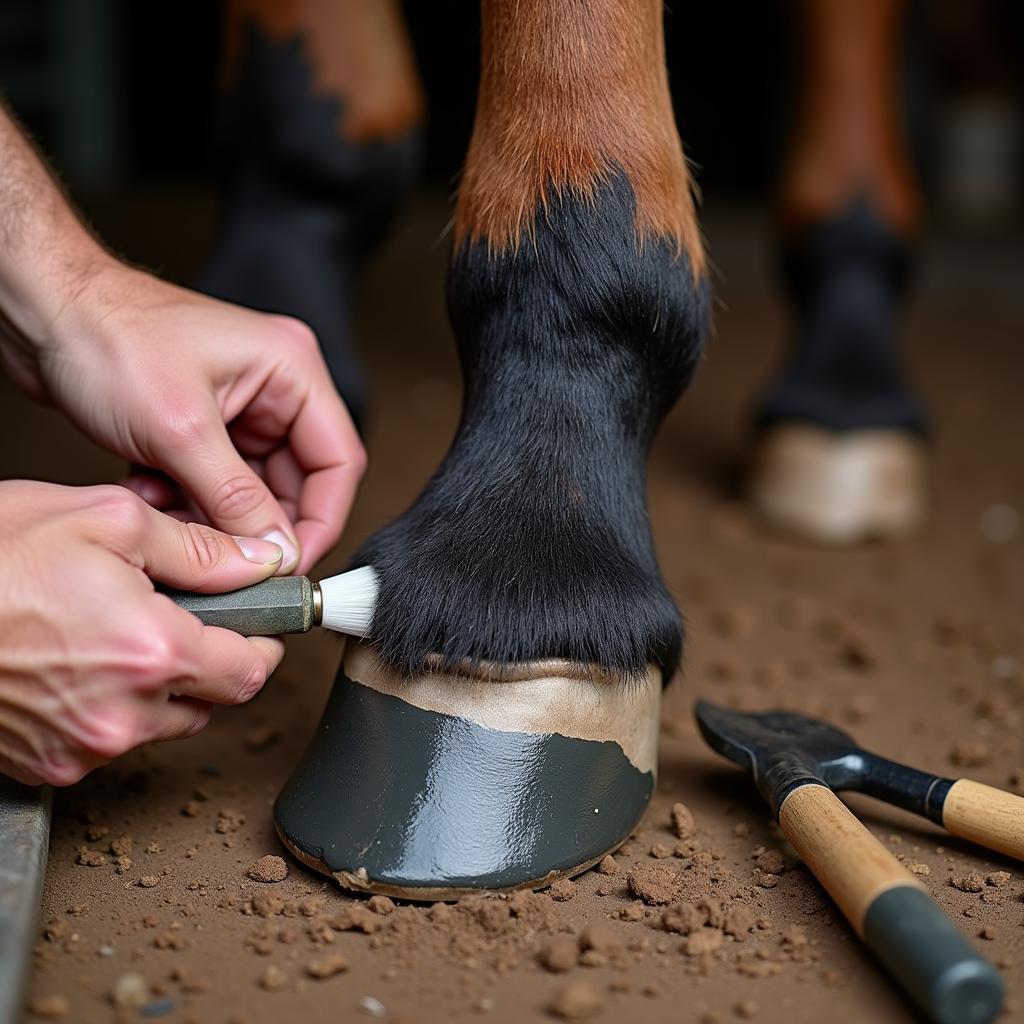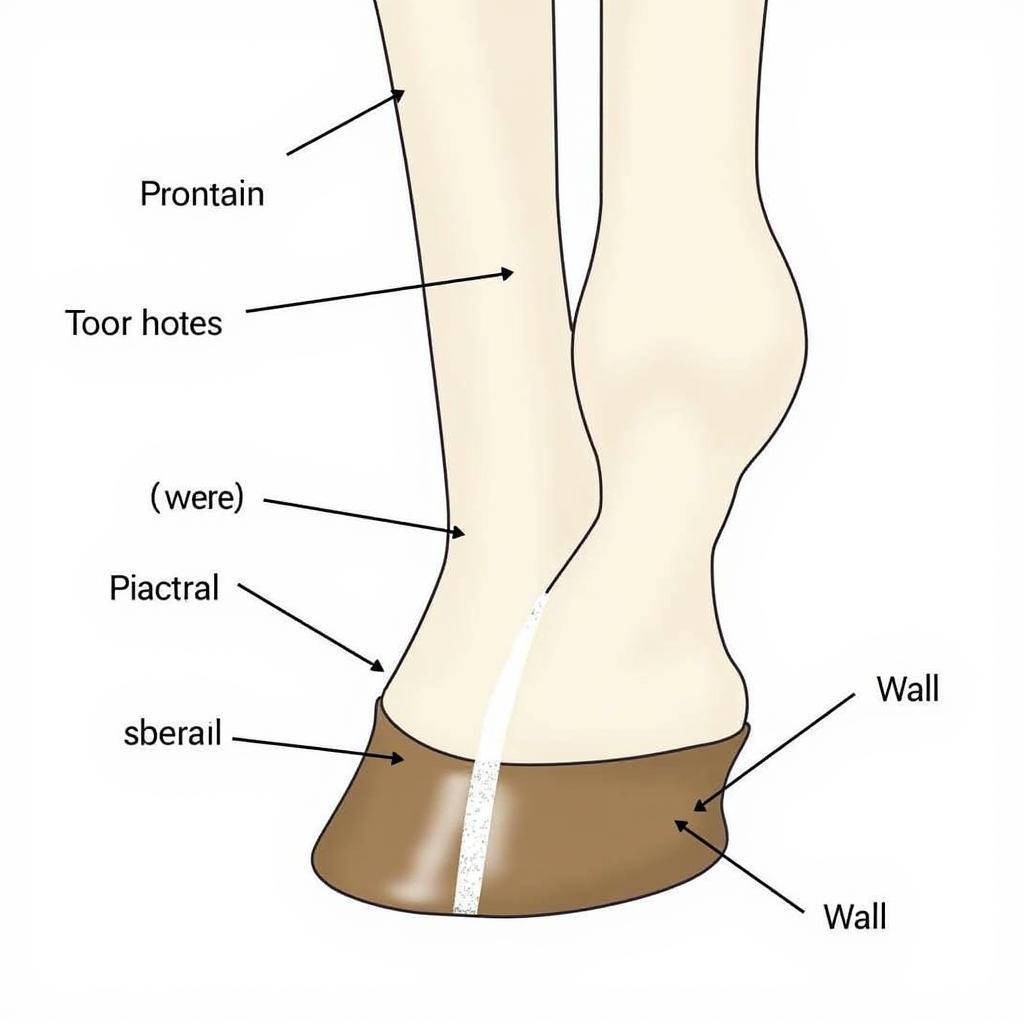Sole paint is a common tool used in equine hoof care. It’s often applied to protect the sole of the hoof from bacterial and fungal infections, especially in wet or muddy conditions. But knowing when and how to use it correctly is crucial for optimal hoof health.
Understanding the Purpose of Sole Paint
Why use sole paint in the first place? Horses’ hooves are constantly exposed to various elements that can lead to problems like thrush, white line disease, and abscesses. Sole paint acts as a barrier, helping to prevent these issues by creating a protective layer against moisture and harmful microorganisms. It can also aid in hardening the sole, making it more resistant to wear and tear. Some horse owners also use sole paint for cosmetic reasons, particularly for show horses. However, the primary function should always be hoof health.
Choosing the right sole paint is also important. Some contain antibacterial and antifungal ingredients, while others primarily focus on creating a waterproof seal. Knowing your horse’s specific needs and environment will help you make the best decision. Are you dealing with a persistent thrush issue or simply looking for preventative measures? This is a key question to consider. Remember, what works for one horse may not be suitable for another. Consult with a farrier or veterinarian if you are unsure which sole paint is right for your horse.
For new horse owners, understanding the basics of horse care is essential. Check out our guide on beginners horse for sale for more information.
Types of Sole Paint and Their Benefits
There are various types of sole paint available, each with its own benefits. Copper sulfate-based paints are known for their antifungal properties, making them effective against thrush. Pine tar-based paints offer a strong waterproof barrier and can help harden the sole. Some paints contain a combination of ingredients to offer broader protection. Understanding the ingredients and their functions is key to selecting the right product.
 Applying Sole Paint to a Horse Hoof
Applying Sole Paint to a Horse Hoof
Applying Sole Paint Correctly: A Step-by-Step Guide
- Clean the hoof: Thoroughly clean the horse’s hoof using a hoof pick and brush, removing any dirt, debris, and loose flakes of hoof material.
- Dry the hoof: Ensure the hoof is completely dry before applying any paint. Moisture trapped beneath the paint can create a breeding ground for bacteria and fungi, worsening the problem.
- Apply the paint: Using a small brush, apply a thin, even coat of sole paint to the sole of the hoof. Avoid getting paint on the frog or sensitive areas of the hoof.
- Let it dry: Allow the paint to dry completely before turning the horse out or putting on shoes. This usually takes a few minutes.
Common Mistakes to Avoid
Over-application of sole paint can be counterproductive. A thick layer can trap moisture and debris, leading to the very problems you’re trying to prevent. Less is more when it comes to sole paint. Another common mistake is applying paint to a dirty or wet hoof. This prevents the paint from adhering properly and reduces its effectiveness. Always ensure the hoof is clean and dry before application.
Are you interested in equine art? Browse our collection of joe andoe horse painting for inspiration.
When to Consult a Farrier or Veterinarian
While sole paint can be a helpful tool, it’s important to know when to seek professional advice. If you’re dealing with a persistent hoof problem, or if your horse shows signs of lameness, consult a farrier or veterinarian. They can diagnose the underlying issue and recommend the appropriate treatment.
“Regular hoof care is paramount to a horse’s well-being,” says Dr. Emily Carter, DVM, specializing in equine podiatry. “Sole paint can be a valuable part of that care, but it’s crucial to use it correctly and address any underlying hoof issues.”
 Horse Hoof Anatomy Diagram
Horse Hoof Anatomy Diagram
Conclusion
Sole paint can be a valuable tool in maintaining your horse’s hoof health. By understanding its purpose, choosing the right product, and applying it correctly, you can help prevent common hoof problems and keep your horse’s hooves in top condition. Remember, regular hoof care is essential, and sole paint should be used as part of a comprehensive hoof care routine. Don’t hesitate to consult a farrier or veterinarian if you have any concerns about your horse’s hooves.
FAQ
- How often should I apply sole paint?
- Can I use sole paint on a horse with shoes?
- What are the signs of thrush in horses?
- What is the difference between sole paint and hoof dressing?
- Are there any natural alternatives to sole paint?
- How can I tell if my horse has white line disease?
- Is sole paint necessary for all horses?
Interested in unique horse-themed items? Check out our selection of horse table lamp. You can also find information about free horses sex and urns with horses on our website.
When you need assistance, don’t hesitate to contact us. Call: 0772127271, Email: [email protected] Or visit us at: QGM2+WX2, Vị Trung, Vị Thuỷ, Hậu Giang, Việt Nam. We have a 24/7 customer service team ready to help.